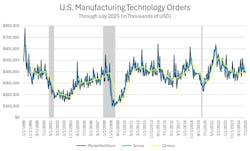Machine Tool Orders Slower but Still Ahead
Purchases of capital equipment by U.S. machine shops and other manufacturers fell to $387.3 million in July, down-9.5% from June but still 20.1% higher than the July 2024 result. The strength of the July data drew the year-over-year total into positive territory for the first time in three months, since April 2025, as noted by AMT - the Assn. for Manufacturing Technology.
For the January-July period, new orders now total $2.91 billion, which is 14.4% higher than the total for the first seven months of 2024.
The source of the data is AMT’s U.S. Manufacturing Technology Orders report, which summarizes manufacturers’ purchases of metal-cutting and metal-forming machinery, according to order value and machine units, nationwide and in six regions. USMTO is an index to future manufacturing activity because it quantifies machining operations’ investments in preparation for new production programs.
AMT suggests that growth in the value of orders obscures that the number of machines sold during July is well below (-13%) the monthly average. “In the absence of widespread inflation among machine tools, this trend underscores the continued importance of automation in current buying trends,” according to AMT’s statement.
Regionally, the July order total was strongest in the North Central-East ($93.2 million), which still represents a -5.5% drop from June. Similarly, in the West ($83.3 million), the new result is -24.5% less than the prior month.
Five of the six regions summarized have positive year-to-date order totals, with particularly strong improvement seen in the South Central (40.2% YTD), West (38.9%), and North Central-East (15.9%.) Only the North Central-West region (-4.2%) has not improved on its January-July order volume.
In its summary, AMT explained that equipment order by contract machine shops (aka “job shops”) fell almost 14% from June to July, but are up nearly 10% from July 2024. This is important because those operations represent the largest buying segment in the USMTO survey, and the slowing activity is “a significant softening relative to the overall market.
“This trend is not uncommon, it shows the first signs of weakness in orders from the largest customer segment, which has otherwise shown signs of recovery for much of 2025,” according to AMT.

